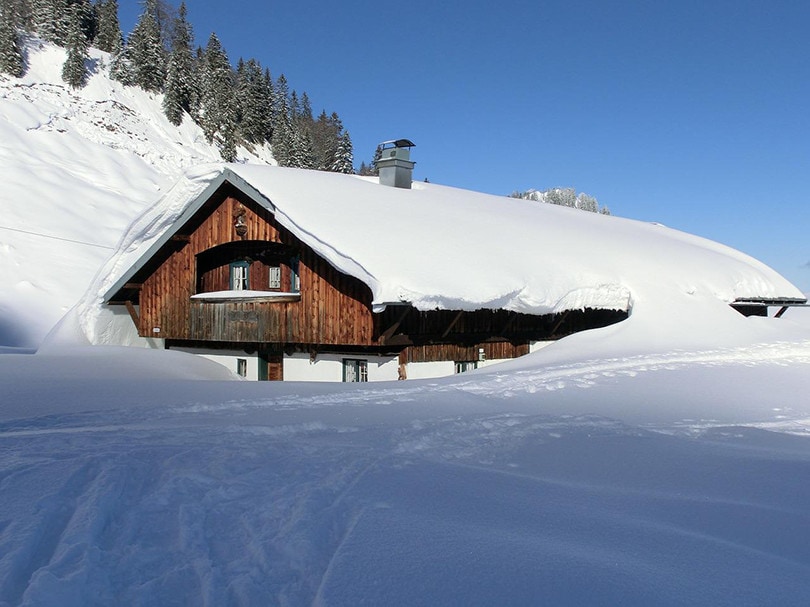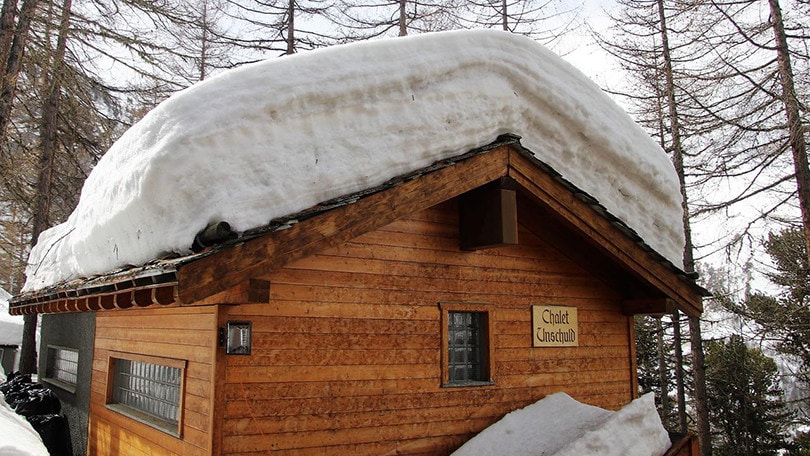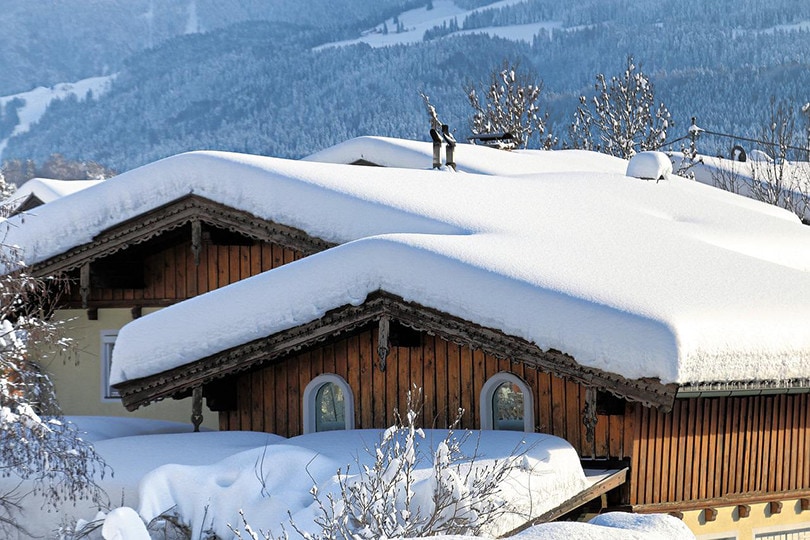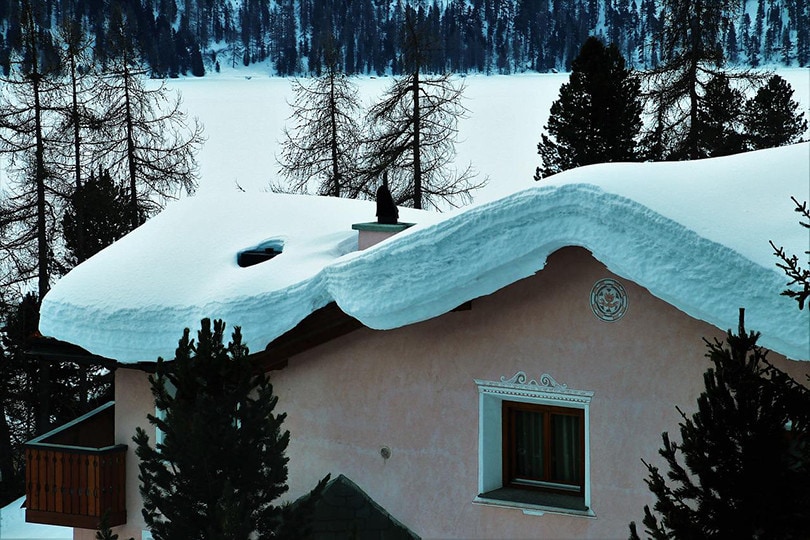How Much Snow Can a Roof Hold? Factors, Risks, & FAQ
-
Pete Ortiz
- Last updated:

Winter is a beautiful season, and many people love snow and all the activities they can take part in. However, snow can be hazardous for our homes, especially to the roof. As the snow collects on the roof, there are possibilities of leaks and other issues that it can cause.
All homeowners should be well aware of the possible damages and know how much snow the roof can hold. If you have any questions, we will provide all the required answers. Typical residential roofs can hold up to 20 pounds of snow per square foot.
Keep reading to learn how much snow a roof can hold and what to do in such a situation.
Factors That Determine the Amount of Snow Your Roof Can Hold

Typical residential roofs can hold up to 20 pounds of snow per square foot. That said, there are a few other factors to take into consideration to determine the amount of snow your roof can hold:
- The snow’s weight: The weight of snow can vary as wet snow is much heavier than fluffy, dry snow. Typically, wet snow is at least twice as heavy as dry snow.
- The structural design of your roof: Snow can usually cause more damage to flat and slightly pitched roofs than to steep and smooth roofs.
- The roof’s material: The type of shingles used is also important when determining how much snow your roof can hold. Asphalt and slate shingles are among the most durable roof material options.
How do I know if the snow is approaching the weight limit of my roof?
When trying to determine if the snow is approaching the weight limit of your roof, you should look at the snow consistency to figure out how heavy it is. These are the typical types of snow you can encounter:
- Wet, fresh snow: 4 feet of wet, fresh snow is around 20 pounds per square foot
- Old, fluffy snow: 2 feet of old fluffy snow is approximately 20 pounds per square foot
- Old and fresh snow mixed: 2 to 3 feet of old and fresh snow mixed weighs around 20 pounds per square foot
Possible Damages Caused From Too Much Snow on Your Roof

Heavy snow accumulating on your roof can cause severe damage to both the roof and the sides of the house. It is important to notice any signs of potential issues in time and resolve them before the snow further damages your roof.
Wood rot
Wood rot and excess water can seriously harm your attic and insulation. When too much snow collects on your roof, the structural wood beneath your roof can cause a lot of damage, which may cause permanent problems to your entire roof structure.
Broken or missing shingles
The most common sign of damage due to too much snow on your roof will be shingles breaking or falling. When a significant amount of your roof shingles show any signs of wear and tear, this can cause further problems such as water leaking, collecting debris, bug infestation, and mold. Without shingles, your attic and roof are exposed to elements that can negatively affect the entire structure.
Leaks in the attic
If the snow accumulates on your roof and you start noticing leaks in your attic, this is a sure sign that there is a big problem going on. You cannot ignore this as it can only cause further issues in your attic. If your attic has poor ventilation, the excess water will start collecting and lead to moisture in your deck, roof, and walls.
Broken and clogged gutters
When your gutter starts to break down, it is a significant sign of roof damage from the snow. Clogged or damaged gutters can lead to the entire draining system failing, causing leaking to the side of the walls and in the attic, ice buildup, and debris collecting in the gutter. When heavy snow accumulates in your gutters, it can cause the entire system to collapse.

Leaking on the walls
Leaking down the side of your exterior walls can cause the walls to absorb all the moisture and even penetrate the inside walls. You can expect mold and mildew to collect very fast on the outside and inside your walls when this happens.
Cracking or warping paint
Cracking and warping paint will cause leaking in the roof and the sides of the house. If you notice your paint warping or cracking, make sure to search around your home for possible water leaking and to fix it as soon as possible before it causes further damage.
Will insurance cover roof damages from the snow?
Most insurance policies cover damages from weather-caused accidents, so the insurance should cover all the repair costs if your roof gets damaged from too much snow.
Still, to be sure, it’s always best to reach out to your insurance company and verify what exactly falls under their policies.

What to Do if There’s Too Much Snow on Your Roof
When the snow on your roof gathers so much that it cannot melt as fast as needed, you’ll need to clean the snow yourself to prevent possible damage. Cleaning the roof from snow can be a dangerous activity, so it’s essential to know some tips and tricks to help you finish the task successfully.
Tips for clearing the snow on your roof safely
First of all, never remove the snow alone. It’s best to have someone to help as climbing on the ladder during snow and ice can be hazardous. If using a ladder, ensure it’s free of snow and that it’s not slippery. You can place it in firm snow on the ground to create a strong surface and prevent it from falling over.
For cleaning, it’s best to use a rake or a plastic shovel that won’t harm the roof structure. You can even consider a telescopic roof rake, so you don’t have to climb to the roof. It will allow you to clear snow from the ground, preventing possible injuries.
When cleaning, first aim to get rid of icicles and snow from the roof’s edges as that might push the excess snow to fall off by itself.
Conclusion
Overall, most roofs are durable and can hold up to 20 pounds of snow per square foot, but it’s always important to inspect the roof and ensure the snow limit doesn’t reach its maximum. We suggest keeping up regular roof maintenance during the winter months to ensure the safety of your home and prevent roof damage.
- “How Much Snow Can a Roof Hold?”
- “How much snow on your roof is too much?”
- “How much snow your roof can support?”
- “Maximum Snow Load On a Roof [Your Ultimate Guide]”
- “How much snow can your roof hold? A guide to snow and ice dams”
- “How much snow can a roof hold? Estimate the weight on top of your home”
- How Winter Storms Can Damage Your Roofing and Siding.
- 6 Signs of Winter Storm Damage to Your Roof You Need to Know
- Spot Signs of Roof Damage During Winter – Lake Orion Roofing, Inc.
Featured Image Credit: jmp71, Pixabay
Contents


